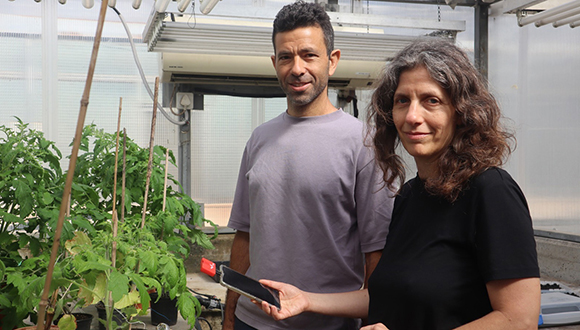
A scientific breakthrough at Tel Aviv University: A world-first study shows an acoustic interaction between plants and insects. In this study, the team focused on female moths and found that they make a critical decision-where to lay their eggs-based on sounds emitted by nearby plants. When plants emitted distress sounds, the female moths preferred healthy plants that were not emitting such sounds. These sounds are ultrasonic, beyond the hearing range of the human ear, but moths can hear them.
The study was conducted in the laboratories of Prof. Yossi Yovel from the School of Zoology and Prof. Lilach Hadany from the School of Plant Sciences and Food Security at TAU's Wise Faculty of Life Sciences. It was led by students Dr. Rya Seltzer and Guy Zer Eshel, in collaboration with scientists from the Plant Protection Institute at the Volcani Institute. The paper was published in the journal eLife.
This study follows the dramatic discovery published by the same researchers about two years ago, which generated worldwide interest: plants under stress emit sounds-at ultrasonic frequencies, above the range of human hearing, but detectable by many animals. The researchers state: "That discovery opened the door to extensive research on acoustic communication between plants and animals. In the present study, we began to explore this subject."
Prof. Yovel explains: "After proving in the previous study that plants produce sounds, we hypothesized that animals capable of hearing these high-frequency sounds may respond to them and make decisions accordingly. Specifically, we know that many insects, which have diverse interactions with the plant world, can perceive plant sounds. We wanted to investigate whether such insects actually detect and respond to these sounds."
Prof. Hadany adds: "We chose to focus on female moths, which typically lay their eggs on plants so that the larvae can feed on them once hatched. We assumed the females seek an optimal site to lay their eggs - a healthy plant that can properly nourish the larvae. Thus, when the plant signals that it is dehydrated and under stress would the moths heed the warning and avoid laying eggs on it? To explore this question, we conducted several experiments would the moths heed the warning and avoid laying eggs on it? To explore this question, we conducted several experiments."

Prof. Yossi Yovel and Prof. Lilach Hadany
In the first experiment, aiming to isolate the auditory component from other plant features like color and scent, the researchers presented the female moths with two boxes: one contained a speaker playing recordings of tomato plants in a state of dehydration, while the other was silent. The moths showed a clear preference for the 'noisy' box, which they likely interpreted as a living plant (even if under stress). Conclusion: the moths do indeed perceive and respond to a playback of plant-emitted sounds. When the researchers neutralized the moths' hearing organs, this preference disappeared and they chose both boxes equally - clear evidence that the preference was specifically based on listening to sounds, and not on other stimuli.
In the second experiment, the female moths were presented with two healthy tomato plants - one with a speaker playing sounds of a drying plant, and one that was silent. Again, they showed a clear preference - but this time for the silent plant, from which no distress sounds were heard, and therefore probably serves as a better site for laying eggs.

In another experiment, the moths again faced two boxes-one silent and the other containing male moths, which also emit ultrasonic sounds at a frequency similar to plant sounds. This time, the females showed no preference and laid their eggs equally on both boxes. The researchers concluded that when deciding where to lay their eggs, the females specifically respond to plant-emitted sounds - and not, for example, to sounds made by males.
The researchers conclude: "In this study, we revealed the first evidence for acoustic interaction between a plant and an insect. We are convinced, however, that this is just the beginning. Acoustic interaction between plants and animals doubtlessly has many more forms and a wide range of roles. This is a vast, unexplored field - an entire world waiting to be discovered."






